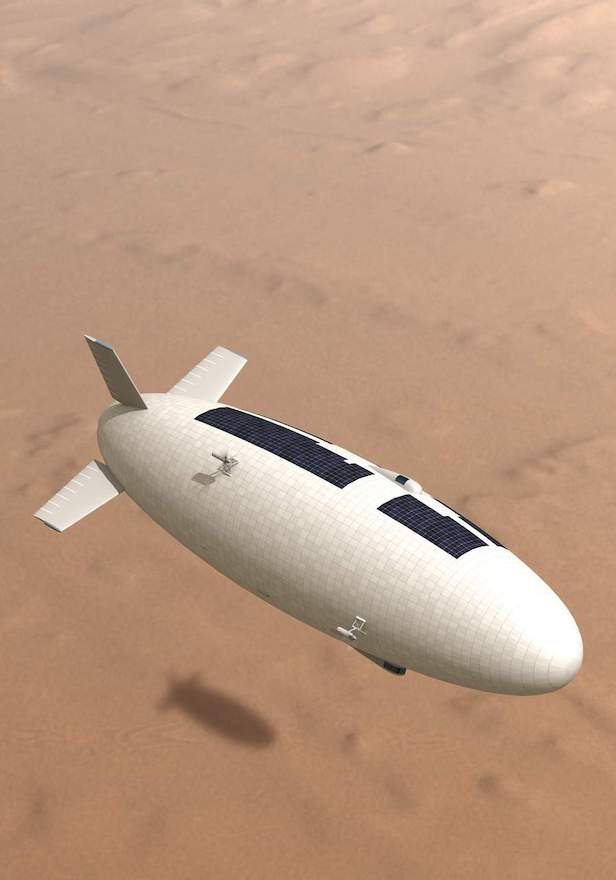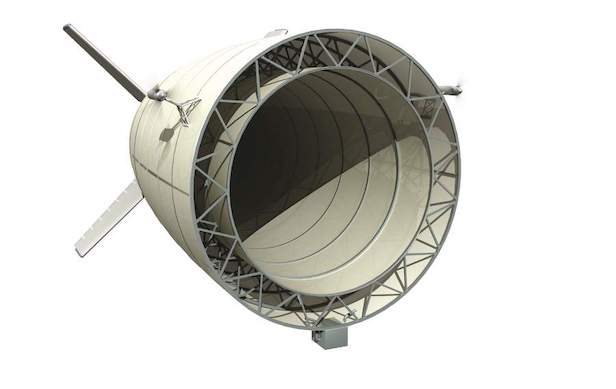Future Tech: Martian Airships
This NASA study has the aim of exploring the Red Planet with the help of empty balloons

The Martian atmosphere offers a unique opportunity in the Solar System to exploit vacuum as a lifting agent, because it is mostly cold, heavy carbon dioxide, but at a low overall pressure. Image credit: All About Space/Adrian Mann
While the Martian rovers Spirit, Opportunity and Curiosity have explored further afield than ever before, the process is frustratingly slow. Curiosity’s top speed is only 200 metres per day, partly due to the difficulty of controlling a robot with a 20-minute round trip communications delay, limiting the reach of our exploration. Numerous proposals have been put forward, for various bodies in the Solar System, for flying probes of various kinds. Free flying balloons (which have been deployed on Venus), dirigible airships, gliders and even hopping probes that jump across terrain; but NASA’s airship study is unique, it will fly on a vacuum lift.
Balloons and airships float in an atmosphere by displacing some of the atmosphere with something lighter; just like the way boats float by displacing (with their hulls) water for air (the space inside their hulls). On Earth we have mostly used either hot air (where the air inside the balloon becomes lighter than the surrounding air as it heats up) or lift gases like hydrogen and helium. Lift gases work because they are less dense than air, but at the same pressure, so flying balloons are not tightly inflated like a party balloon. At standard sea level pressure every cubic metre contains 1.292 kilograms of air, but a cubic metre of hydrogen or helium contains only 90 grams or 178 grams respectively; producing a lift of 1.202 kilograms or 1.114 kilograms.
Now, as lift depends on the mass of gas you can push out of the way, in theory the best possible balloon would have nothing in it at all and provide the full 1.292 kilograms lift for every cubic metre. Indeed some of the first scientists to think about balloons considered this, but the lift gases are also there to hold the shape of the balloon against the surrounding pressure; so on Earth a vacuum balloon is impractical because it would have to be far heavier than it could lift to be strong enough to hold up against the atmospheric pressure around it. But things could be different on Mars.

A lattice work of lightweight girders connect the inner skin to the outer shell. The inner envelope is the volume where the atmosphere is removed from, creating lift by displacing Martian air for empty space, and the external shell of the vacuum airship will support the load of the atmosphere squeezing in on the evacuated space. Image credit: All About Space/Adrian Mann
That is what Professor John-Paul Clarke of the Georgia Institute of Technology is investigating, and Mars offers a number of advantages to the potential vacuum balloonist. Its atmosphere is predominately carbon dioxide, which is much denser than air, it is very cold which also helps atmospheric density, yet at the same time Mars’ surface pressure is only 1/160th of Earth’s. These factors mean that the atmosphere is a better mix for supporting balloons (in Venus’ dense carbon dioxide atmosphere normal Earth air works as a lifting gas), but that a vacuum balloon does not have to support such a crushing load. Clarke’s proposal is for a rigid balloon with two layers, an inner shell containing the vacuum, supported by a lattice of lightweight beams connecting to the outer shell.
A vacuum airship’s big advantages for exploring Mars are its ability to travel quickly regardless of terrain, and the fact it doesn’t need a finite reserve of lift gas. Vacuum is an infinite resource, all the airship needs is a source of power for a pump to empty the envelope, and its outer shell provides more than enough area for solar panels to provide electricity. This means it can fly and land repeatedly without running out of gas, and even offer the prospect of future Martian transport ships that essentially fly for free and can be ‘filled’ anywhere on the planet. Although they sound like something from space fantasy, vacuum-filled Zeppelins could be the backbone of the M Martian transport network.
Keep up to date with the latest news in All About Space –available every month for just £4.99. Alternatively you can subscribe here for a fraction of the price!




